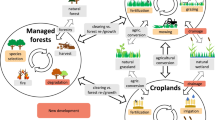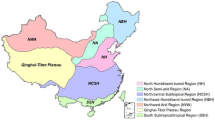Abstract
Purpose
Climate change impacts in life cycle assessment (LCA) are usually assessed as the emissions of greenhouse gases expressed with the global warming potential (GWP). However, changes in surface albedo caused by land use change can also contribute to change the Earth’s energy budget. In this paper we present a methodology for including in LCA the climatic impacts of land surface albedo changes, measured as CO2-eq. emissions or emission offsets.
Methods
A review of studies calculating radiative forcings and CO2-equivalence of changes in surface albedo is carried out. A methodology is proposed, and some methodological issues arising from its application are discussed. The methodology is applied in a practical example dealing with greenhouse agriculture in Southern Spain.
Results
The results of the case study show that the increase in surface albedo due to the reflective plastic cover of greenhouses involves an important CO2-eq. emission offset, which reduces the net GWP-100 of tomato production from 303 to 168 kg CO2-eq. per ton tomato when a 50-year service time is considered for the agricultural activity. This example shows that albedo effects can be very important in a product system when land use plays an important role, and substantial changes in surface albedo are involved.
Conclusions
Although the method presented in this work can be improved concerning the calculation of radiative forcing, it constitutes a first operative approach which can be used to develop regionalized characterization factors and provide a more complete evaluation of impacts on the climate change impact category.


Similar content being viewed by others
References
Akbari H, Menon S, Rosenfeld A (2009) Global cooling: increasing world-wide urban albedos to offset CO2. Climatic Change 94(3–4):275–286
Antón A (2004) Utilización del Análisis de Ciclo de Vida en la evaluación del impacto ambiental del cultivo bajo invernadero mediterráneo. Universitat Politècnica de Catalunya, Barcelona, Doctoral Thesis
Antón A, Montero JI, Muñoz P, Castells F (2005) LCA and tomato production in Mediterranean greenhouses. Int J Agric Resources, Governance Ecol 4(2):102–112
Bala G, Caldeira K, Wickett M, Phillips TJ, Lobell DB, Delire C, Mirin A (2007) Combined climate and carbon-cycle effects of large-scale deforestation. P Natl Acad Sci USA 104(16):6550–6555
Betts RA (2000) Offset of the potential carbon sink from boreal forestation by decreases in surface albedo. Nature 408(6809):187–190
Bird DN, Kunda M, Mayer A, Schlamadinger B, Canella L, Johnston M (2008) Incorporating changes in albedo in estimating the climate mitigation benefits of land use change projects. Biogeosci Disc 5(2):1511–1543
Brandão M, Milà i Canals Ll, Clift R (2010) Soil organic carbon changes in the cultivation of energy crops: implications for GHG balances and soil quality for use in LCA. Biomass Bioenerg (in press)
Breuer L, Eckhardt K, Frede HG (2003) Plant parameter values for models in temperate climates. Ecol Model 169(2–3):237–293
BSI (2008) PAS 2050:2008. Specification for the assessment of the life cycle greenhouse gas emissions of goods and services. ISBN 978 0 580 50978 0
Campra P, García M, Cantón Y, Palacios-Orueta A (2008) Surface temperature cooling trends and negative radiative forcing due to land use change toward greenhouse farming in southeastern Spain. J Geophys Res 113:D18109
Chen TS, Ohring G (1985) On the relationship between clear-sky planetary and surface albedos: a parameterization for simple energy balance climate models. Adv Space Res 5(6):141–144
Cherubini F, Bird ND, Cowie A, Jungmeier G, Schlamadinger B, Woess-Gallasch S (2009) Energy- and greenhouse gas-based LCA of biofuel and bioenergy systems: key issues, ranges and recommendations. Resour Conserv Recy 53(8):434–447
Chimklai P, Hagishima A, Tanimoto J (2004) A computer system to support Albedo calculation in urban areas. Build Environ 39(10):1213–1221
De Schryver AM, Brakkee KW, Goedkoop MJ, Huijbregts MAJ (2009) Characterization factors for global warming in life cycle assessment based on damages to humans and ecosystems. Environ Sci Technol 43(6):1689–1695
Denman KL, Brasseur G, Chidthaisong A, Ciais P, Cox PM et al (2007) Couplings between changes in the climate system and biogeochemistry. In: Solomon S et al (eds) Climate change 2007: the physical science basis. Contribution of working group I to the fourth assessment report of the intergovernmental panel on climate change. Cambridge University Press, Cambridge, pp 499–588
EC (2008) Photovoltaic Geographical Information System (PVGIS). http://re.jrc.ec.europa.eu/pvgis/index.htm. Accessed 22 Oct 2009
European Union (2009) Directive 2009/28/EC of the European Parliament and of the Council of 23 April 2009 on the promotion of the use of energy from renewable sources and amending and subsequently repealing Directives 2001/77/EC and 2003/30/EC. Official Journal of the European Union L-140: 16–62
Forster P, Ramaswamy V, Artaxo P, Berntsen T, Betts R et al (2007) Changes in atmospheric constituents and in radiative forcing. In: Solomon S et al (eds) Climate change 2007: the physical science basis. Contribution of working group I to the fourth assessment report of the intergovernmental panel on climate change. Cambridge University Press, Cambridge, pp 129–234
Frischknecht R, Jungbluth N (eds.) (2007) Overview and methodology. Final report ecoinvent, v2.0 no. 1. Swiss Centre for Life Cycle Inventories, Duebendorf.
Frischknecht R, Althaus HJ, Bauer C et al (2007) The environmental relevance of capital goods in life cycle assessments of products and services. Int J Life Cycle Asses 12(1):7–17
Gates DM (1980) Biophysical ecology. Springer, New York
Hamwey RM (2007) Active amplification of the terrestrial albedo to mitigate climate change: an exploratory study. Mitig Adapt Strategies Glob Chang 12(4):419–439
Huijbregts MAJ, Schopp W, Verkuijlen E, Heijungs R, Reijnders L (2000) Spatially explicit characterization of acidifying and eutrophying air pollution in life-cycle assessment. J Ind Ecol 4:75–92
Iqbal M (1983) An introduction to solar radiation. Academia Press, Toronto
Joos F, Colin Prentice I, Sitch S, Meyer R, Hooss G, Plattner GK, Gerber S, Hasselmann K (2001) Global warming feedbacks on terrestrial carbon uptake under the Intergovernmental Panel on Climate Change (IPCC) emission scenarios. Glob Biogeochem Cycles 15:891–908
Koerber GR, Edwards-Jones G, Hill PW, Milà i Canals Ll, Nyeko P, York EH, Jones DL (2009) Geographical variation in carbon dioxide fluxes from soils in agro-ecosystems and its implications for life-cycle assessment. J Appl Ecol 46(2):306–314
Kondratyev KY (1969) Radiation in the atmosphere. Academia Press, New York
Kondratyev KY (1972) Radiation processes in the atmosphere. World Meteorological Organization, Geneva
Le Treut H, Somerville R, Cubasch U, Ding Y, Mauritzen C et al (2007) Historical overview of climate change. In: Solomon S et al (eds) Climate change 2007: the physical science basis. Contribution of working group I to the fourth assessment report of the intergovernmental panel on climate change. Cambridge University Press, Cambridge
Lenton TM, Vaughan NE (2009) The radiative forcing potential of different climate geoengineering options. Atmos Chem Phys 9:5539–5561
Lindeijer E, Müller-Wenk R, Steen B (2002) Impact assessment of resources and land use. In: Udo de Haes HA, Finnveden G, Goedkoop M, Hauschild M, Hertwich EG, Hofstetter P, Jolliet O, Klöpffer W, Krewitt W, Lindeijer EW, Müller-Wenk R, Olsen SI, Pennington DW, Potting J, Steen B (eds). Life cycle impact assessment: striving towards best practice. SETAC, Pensacola, pp 11–64
Milà i Canals Ll, Clift R, Basson L, Hansen Y, Brandão M (2006) Expert workshop on land use impacts in life cycle assessment (LCA). Int J Life Cycle Assess 11(5):363–368
Milà i Canals Ll (2007) Land use in LCA: a new subject area and call for papers. Int J Life Cycle Assess 12(1):1
Milà i Canals Ll, Bauer C, Depestele J, Dubreuil A, Freiermuth KRF et al (2007a) Key elements in a framework for land use impact assessment in LCA. Int J Life Cycle Assess 12(1):5–15
Milà i Canals Ll, Bauer C, Depestele J, Dubreuil A, Freiermuth KRF et al (2007b) Key elements in a framework for land use impact assessment in LCA. Int J Life Cycle Assess 12(1):2–4
Muñoz I, Gómez MM, Fernández-Alba AR (2009) Life Cycle Assessment of biomass production in a Mediterranean greenhouse using different water sources: groundwater, treated wastewater and desalinated seawater. Agr Syst 103(1):1–9
Myhre G, Highwood EJ, Shine KP, Stordal F (1998) New estimates of radiative forcing due to well mixed greenhouse gases. Geophys Res Lett 25(14):2715–2718
Pielke RA, Marland G, Betts RA, Chase TN, Eastman JL, Niles JO, Niyogi DDS, Running SW (2002) The influence of land-use change and landscape dynamics on the climate system: relevance to climate-change policy beyond the radiative effect of greenhouse gases. Phil Trans R Soc A 360(1797):1705–1719
Ramaswamy V et al (2001) Radiative forcing of climate change. In: Houghton JT et al (eds) Climate change 2001: the scientific basis. Contribution of working group I to the third assessment report of the intergovernmental panel on climate change. Cambridge University Press, Cambridge, pp 349–416
Ridgwell A, Singarayer J, Hetherington A, Valdes P (2009) Tackling regional climate change by leaf albedo bio-geoengineering. Curr Biol 19(2):146–150
Sanjuan JF (2007) Deteccion de la superficie invernada en la provincia de Almeria a traves de imágenes Aster. Fundacion para la Investigacion Agraria de la Provincia de Almeria, Almeria
Schimel D, Alves D, Enting I, Heimann M et al (1995) CO2 and the carbon cycle. In: Houghton JT (ed) Climate change 1995. The science of climate change, chapter 2. Cambridge University Press, Cambridge, pp 65–131
Silalertruksa T, Gheewala SH, Sagisaka M (2009) Impacts of Thai bio-ethanol policy target on land use and greenhouse gas emissions. Appl Energ 86(suppl 1):S170–S177
Steen B (1999a) A systematic approach to Environmental Priority Strategies in product development (EPS). Version 2000-general system characteristics. Chalmers University, Göteborg, CPM report
Steen B (1999b) A systematic approach to Environmental Priority Strategies in product development (EPS), Version 2000—models and data of the default method. Chalmers University, Göteborg, CPM report
Swiss Centre for Life Cycle Inventories (2008) The ecoinvent database. http://www.ecoinvent.ch/. Accessed 6 Oct 2009
Taha H, Akbari H, Rosenfeld A, Huang J (1988) Residential cooling loads and the urban heat island—the effects of albedo. Build Environ 23(4):271–283
Trenberth KE, Fasullo JT, Kiehl JT (2009) Earth’s global energy budget. B Am Meteorol Soc 90:311–323
Udo de Haes H (2006) How to approach land use in LCIA or, how to avoid the Cinderella effect? Int J Life Cycle Assess 11(4):219–221
Udo de Haes HA, Jolliet O, Finnveden G, Hauschild M, Krewitt W, Mueller-Wenk R (1999) Best available practice regarding impact categories and category indicators in life cycle impact assessment: Part 1. Int J Life Cycle Assess 4:66–74
Xiong X, Chiang K, Sun J, Barnes WL, Guenther B, Salomonson VV (2009) NASA EOS Terra and Aqua MODIS on-orbit performance. Adv Space Res 43(3):413–422
Yin X (1998) The albedo of vegetated land surfaces: systems analysis and mathematical modeling. Theor Appl Climatol 60:121–140
Acknowledgments
The authors acknowledge the useful comments made during the preparation of this paper by Neil Bird, from Joanneum Research and Assumpció Antón from Institut de Recerca i Tecnologia Agroalimentària (IRTA).
Author information
Authors and Affiliations
Corresponding author
Additional information
Responsible editor: Llorenc Milà i Canals.
Electronic supplementary material
Below is the link to the electronic supplementary material.
ESM 1
(PDF 161 kb)
Rights and permissions
About this article
Cite this article
Muñoz, I., Campra, P. & Fernández-Alba, A.R. Including CO2-emission equivalence of changes in land surface albedo in life cycle assessment. Methodology and case study on greenhouse agriculture. Int J Life Cycle Assess 15, 672–681 (2010). https://doi.org/10.1007/s11367-010-0202-5
Received:
Accepted:
Published:
Issue Date:
DOI: https://doi.org/10.1007/s11367-010-0202-5




